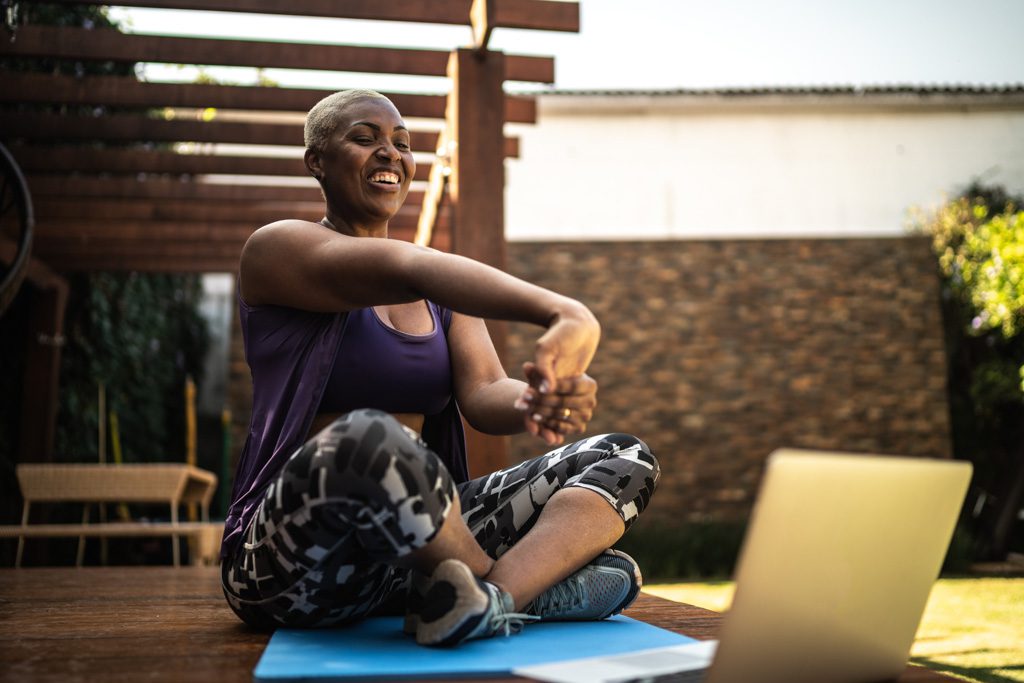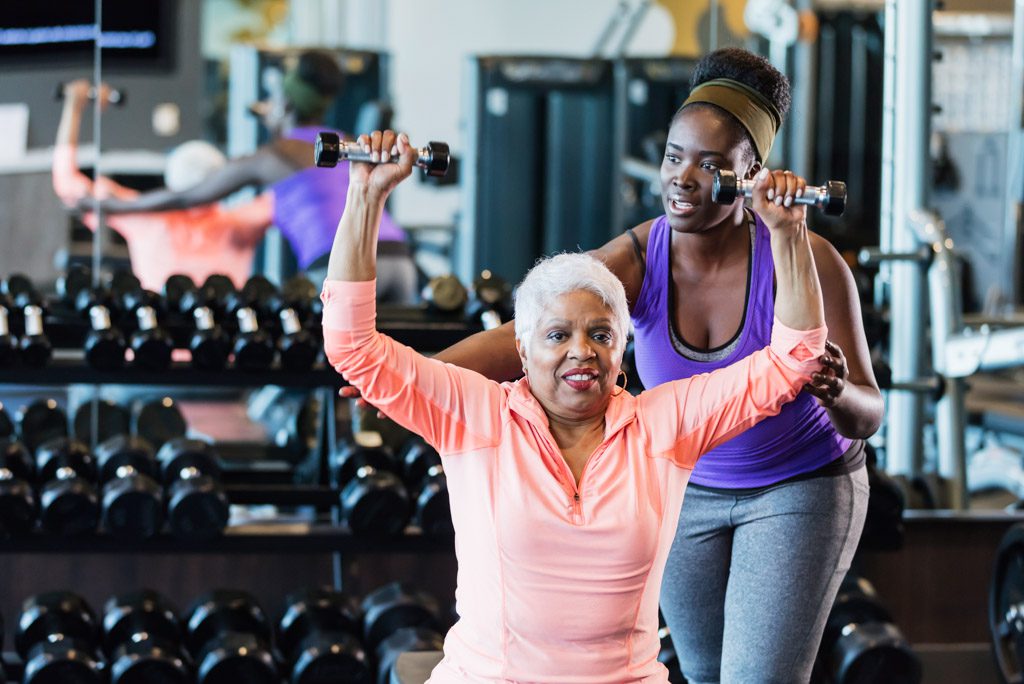What does a personal trainer do and how do trainers help clients?
The list of duties is long, and it’s changing—especially as the COVID Crisis forced the fitness industry to evolve in 2020 and 2021.
Below, we’ll lay out exactly what personal trainers do. The info will be helpful if you’re a client thinking about working with a trainer, someone who is thinking about becoming a personal trainer, or a current coach who wants to know how the industry is evolving.
Be warned: Our list is more complete than most articles that just list duties like demonstrating exercises, modifying routines and monitoring progress. Personal trainers do that stuff. But successful coaches do a lot more.
Here, we’re going to give you the definitive answer to the question “what do successful personal trainers do?”
What Does a Personal Trainer Do? Here’s the Short Answer
In one sentence: A personal trainer works one on one to help a client accomplish health and fitness goals.
The best trainers employ any and every method they are qualified to use to accomplish those goals. They work with their clients to create milestones and they track progress with metrics their clients care about. They constantly evaluate progress and adjust the program regularly to ensure the client is always moving closer to his or her goals.
In 2021, personal trainers recognize that movement is important but isn’t everything. Nutrition, recovery, stress management and motivation are just as important as exercise technique. So top modern trainers take a holistic approach while staying within their scopes of practice (see below).
Finally, personal trainers create close relationships with clients and keep them motivated. This point is often overlooked—but it’s extremely important. No client cares about the Krebs cycle and the SAID principle. Yet trainers often focus on these things.
No anatomy and physiology knowledge will ever be more important than the ability to make a client smile and show up to train. Studying the National Strength and Conditioning Association’s “Essentials of Strength Training and Conditioning” for the fourth time? Maybe spend some time with “How to Win Friends and Influence People” or any of the other entries on our list of the best books for personal trainers.
Remember: The best workout is the one the client will do. The best trainer is the one who can get the client to do that workout and keep coming back for more.
Personal Trainers and Clients’ Goals
It’s important to reiterate that the client’s goals are always primary.
This might seem obvious. But many personal trainers actually forget to ask clients what they really want. They’re weighed down by exercise physiology dogma or attached to a certain training method, like Pilates or bodybuilding or aerobics or barre or HIIT or TRX training. With the best intentions, they make assumptions about clients and don’t ask enough questions.
For example, a trainer holding a CrossFit Level 1 Certificate (CF-L1) might assume that all clients want to improve Fran times or set clean-and-jerk records. That might be true for some. But many others will want to lose weight or get stronger. And they won’t care about the exact method as long as they lose weight. CrossFit can help them, but they aren’t hiring the trainer to do CrossFit. All they want is a lower number on the scale.
Another example: A trainer who is a Certified Strength and Conditioning Specialist might be very proud of the designation issued by the National Strength and Conditioning Association (NSCA). She studied hard to learn about anatomy and physiology, agility drills, plyometrics and skin-fold measurements. She acquired other credentials that are well regarded by strength coaches.
So she starts every client with a Functional Movement Screen and caliper testing to measure body fat. Then she talks about testing procedures and advanced athletic training protocols.
But her new client just wants to be strong enough to care for an aging parent. He doesn’t care about anything else.

Use All Training Tools
Trainers exist to help clients accomplish their goals. Wise coaches never forget that.
Good personal trainers find out about their clients’ goals through consultations, and then they create plans for success. Those plans should be tailored to the client; they should not be based on the trainer’s preferences or on dogma. The method of training is irrelevant. It’s just a tool used to get a result.
You might believe CrossFit is the best way to make a client fit. And maybe it is. But if the client doesn’t enjoy that style of training, you’re going to need to find another way.
Scope of Practice
When someone asks “what do personal trainers do?” the term “scope of practice” will always come up.
Simply put, personal trainers should only do that which they are qualified to do.
For example, personal trainers cannot diagnose and treat injuries unless they have advanced education that specifically allows them to do so. For example, a personal trainer who is also a credentialed physiotherapist would have a greater scope of practice than a coach with a single basic personal-training credential.
Good personal trainers know exactly what they are qualified to do. If they are unqualified, they care for their clients by referring to trusted professionals with the necessary qualifications. For example, a trainer might develop a relationship with a local chiropractor who can advise the trainer on how to keep an injured client moving safely.
All certifying bodies will lay out what their credential holders may and may not do. And insurance will not cover activities outside a coach’s scope of practice.
For a review of top certifications for personal trainers, click here. We review the essential details of credentials from the bodies below, including cost, prerequisites and continuing education requirements. You can find links to the info pages for each credential in that article.
- American College on Exercise (ACE)
- Athletics and Fitness Association of America (AFAA)
- American College of Sports Medicine (ACSM)
- International Sports Science Association (ISSA)
- National Strength and Conditioning Association (NSCA)
- National Academy of Sports Medicine (NASM)

Multiple Credentials for Personal Trainers
ASCM-CPT, NSCA CSCS, NASM-CPT, CrossFit CF-L2—what does a personal trainer do with all those credentials?
In the fitness world, more credentials aren’t better. A huge collection only shows that you’re good at passing tests. They generally don’t allow personal trainers to “do more stuff.” Scope of practice generally remains the same with all PT credentials, and different education is needed to allow trainers to do more.
That said, a personal trainer can and should pursue continuing education. This is a good idea whether a credential requires it or not. The best coaches are always learning so they can serve their clients better. And if it’s obvious that another credential will enable the trainer to help clients to a greater degree, it should be acquired.
With gyms closed, the COVID Crisis showed trainers that they need to offer more to their clients—in person when possible or online when needed. The best coaches in the world now address moving, sleeping, eating and managing stress. Two-Brain Coaching offers credentials that give coaches the qualifications they need to help clients in those areas.
If you’re just starting out, we recommend you acquire one personal training credential (this list can help). Then gain experience working with clients. To increase your value to clients, consider earning a credential in a related field, such as nutrition coaching.

What Does a Personal Trainer Do: The Nitty Gritty
If a trainer works in a Two-Brain gym, he or she will have access to marketing materials, an audience, sales systems, booking and billing software, equipment, insurance and so on. If you want to scale up fast, working in a Two-Brain gym is the best way to do it because the gym owner will take care of most of the details, leaving the trainer free to coach.
In this situation, a trainer will design, implement and update training plans. Secondary duties might include providing the gym with media and marketing material, some booking and billing duties and so on. But the primary responsibility is service delivery.
If a trainer is on his or her own, service delivery is just a small piece of the puzzle.
Additional duties are described in detail below.
Sales and Retention
On a day-to-day basis, an independent personal trainer consults with prospective clients and offers prescriptions for success. This is the “sales process.” Many trainers don’t think about it at all and consider their job only to train clients—but where do the clients come from?
On your own, you’ll need to find way to get clients, either through Affinity Marketing (get our free guide here) or through other methods, such as social media audience building, paid marketing and so on. You might believe you’re a coach, but make no mistake: If there’s no sales system in place for you, you are the salesperson. And if you don’t do that job, you don’t get to be a personal trainer. Few trainers realize this.
You’re also in charge of retention—which is essentially “extended sales.” You have to sell your service every day, and while many gyms have client success managers to handle retention, it’s your job when you’re solo. That means you’ll have to perform goal reviews with current clients, take measurements, send out cards and gifts, text congrats, provide resources, and so on.
Sales and retention are the last things most trainers think about. But unless someone is feeding you clients, these are actually critical jobs for a personal trainer.
Space, Insurance and Equipment
If you’re on your own, you’ll need a place to train. You can rent space, train in a client’s home or train outdoors (this often requires a permit in public places). If you rent and are the only tenant, general cleaning falls on the trainer’s shoulders as well.
You’ll need insurance that covers your activities—wherever they are—and equipment. It’s worth noting that you don’t need a ton of equipment to start training clients. The video below will tell you that you can start a gym—or a PT business—with just a few pieces of gear.
Equipment maintenance and cleaning is also your job. If you train outdoors or in clients’ homes, you’ll be moving equipment regularly, too.
Admin Duties
Independent trainers also have to take on all the admin tasks a general manager or administrator would do at a gym. They include serving and filing waivers and health questionnaires, booking intake consultations and training appointments, processing payments, and maintaining some sort of database.
Some trainers are very casual about these tasks, and they generally end up losing money. Admin work is extremely important and shouldn’t be neglected.

What Does a Personal Trainer Do: Some Coaching!
Finally, personal trainers of course spend a lot of time coaching. The list above isn’t meant to obscure that fact. But too many people don’t realize that coaching is just part of a trainer’s job.
Coaching refers to all the fun stuff trainers signed up for: creating and delivering training plans (perhaps through an app—the best ones are evaluated here), as well as leading clients through fun, effective, safe workouts.
This is where you get to crank the music, fire clients up, teach and instruct, correct form and motivate. You’re the expert with the exact plan for your client, and you’re leading him or her to success. The satisfaction of coaching someone to a new goal is unmatched, and it will get you out of bed every morning.
2021 Evolution: Additional Duties for Personal Trainers and Coaches
Exercise technique and movement coaching is important, but the best personal trainers know that this is just a small part of coaching a client to success.
When the COVID Crisis hit and trainers couldn’t work with clients in person, it became obvious that providing accountability was even more important than perfecting squat technique. The trainers who thrived during COVID often couldn’t interact with their clients, but they still delivered daily workouts, briefs and tips. They also explained how the workouts related to the clients’ goals and made sure the clients did the work.
In late 2020 and into 2021, trainers stayed connected with their clients and provided huge amounts of support through apps or just simple texts and email. They also found they could offer more value, so they coached clients on sleeping, eating and stress management. They provided videos, education, helpful links, various challenges and so on.
Overall, the COVID Crisis showed personal trainers that their work isn’t just done in the gym. That might have been true 10 or 20 years ago. Now, the modern personal trainer is more of a “life coach” than a simple fitness expert.
For info on how to become a more complete personal trainer, check out the Two-Brain Coaching blog.

This Above All: Make a Business Plan
If you’ve read this far, you know a personal trainer isn’t just a coach. He or she is an entrepreneur. Before you commit to the career, create a business plan. Here’s one we made for you—it’s free: “Personal Trainer Business Plan.”
This is the key question: “Can I really coach eight or more hours a day and give my clients the best service?” When you’re fresh and raring to go, you’ll probably say “hell, yes!”
But the answer is “no.”
Many, many trainers have learned this lesson the hard way. Don’t follow that path.
Another question: “Are the rates I’m charging going to support me and my family?”
Do the math—even if you hate numbers. Your rates must support you or your career as a personal trainer will be short.
Two-Brain founder Chris Cooper once coached 13 hours in a row and still didn’t make enough money to provide for his family. He was burned out, and his clients weren’t getting his best. You don’t have to make that same mistake.
The most successful personal trainers make a business plan before they invest in the career.
Our advice—which is based on data—is to work with a Two-Brain gym owner who will help you create an exact plan to make what you need to make and thrive as a coach. Even better, this path lets you coach more and do less of the other duties that aren’t as fun—like cleaning toilets and updating databases.
What Do Personal Trainers Do? Almost Everything!
The info here will give you a great idea what coaches do.
Our answer is more complete than most because we come at it from a business perspective. That’s really the only way to look at the job—because you need to generate income.
If you’re thinking about becoming a personal trainer, it would be a mistake to ignore all the aspects of the job that don’t involve creating training plans and coaching movement. Too many people who love fitness have done this. Instead of thriving, they burn out and lose their passion because they never considered all the aspects of the job.
If you want to become a personal trainer, you need the complete picture.
And if you need help making a plan, you need a mentor.

